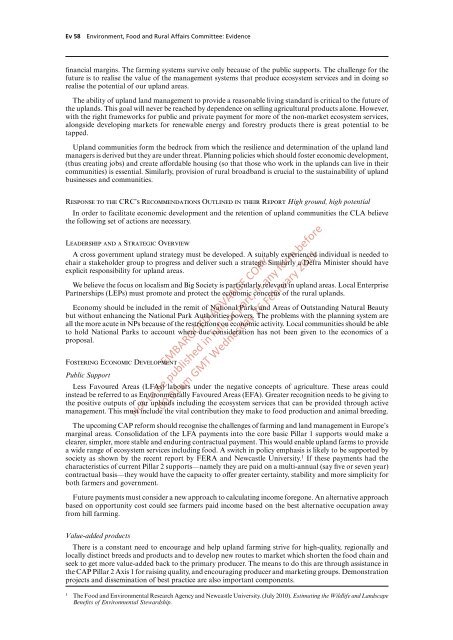Farming in the Uplands - ARCHIVE: Defra
Farming in the Uplands - ARCHIVE: Defra
Farming in the Uplands - ARCHIVE: Defra
You also want an ePaper? Increase the reach of your titles
YUMPU automatically turns print PDFs into web optimized ePapers that Google loves.
Ev 58 Environment, Food and Rural Affairs Committee: Evidence<br />
f<strong>in</strong>ancial marg<strong>in</strong>s. The farm<strong>in</strong>g systems survive only because of <strong>the</strong> public supports. The challenge for <strong>the</strong><br />
future is to realise <strong>the</strong> value of <strong>the</strong> management systems that produce ecosystem services and <strong>in</strong> do<strong>in</strong>g so<br />
realise <strong>the</strong> potential of our upland areas.<br />
The ability of upland land management to provide a reasonable liv<strong>in</strong>g standard is critical to <strong>the</strong> future of<br />
<strong>the</strong> uplands. This goal will never be reached by dependence on sell<strong>in</strong>g agricultural products alone. However,<br />
with <strong>the</strong> right frameworks for public and private payment for more of <strong>the</strong> non-market ecosystem services,<br />
alongside develop<strong>in</strong>g markets for renewable energy and forestry products <strong>the</strong>re is great potential to be<br />
tapped.<br />
Upland communities form <strong>the</strong> bedrock from which <strong>the</strong> resilience and determ<strong>in</strong>ation of <strong>the</strong> upland land<br />
managers is derived but <strong>the</strong>y are under threat. Plann<strong>in</strong>g policies which should foster economic development,<br />
(thus creat<strong>in</strong>g jobs) and create aVordable hous<strong>in</strong>g (so that those who work <strong>in</strong> <strong>the</strong> uplands can live <strong>in</strong> <strong>the</strong>ir<br />
communities) is essential. Similarly, provision of rural broadband is crucial to <strong>the</strong> susta<strong>in</strong>ability of upland<br />
bus<strong>in</strong>esses and communities.<br />
Response to <strong>the</strong> CRC’s Recommendations Outl<strong>in</strong>ed <strong>in</strong> <strong>the</strong>ir Report High ground, high potential<br />
In order to facilitate economic development and <strong>the</strong> retention of upland communities <strong>the</strong> CLA believe<br />
<strong>the</strong> follow<strong>in</strong>g set of actions are necessary.<br />
Leadership and a Strategic Overview<br />
A cross government upland strategy must be developed. A suitably experienced <strong>in</strong>dividual is needed to<br />
chair a stakeholder group to progress and deliver such a strategy. Similarly a <strong>Defra</strong> M<strong>in</strong>ister should have<br />
explicit responsibility for upland areas.<br />
We believe <strong>the</strong> focus on localism and Big Society is particularly relevant <strong>in</strong> upland areas. Local Enterprise<br />
Partnerships (LEPs) must promote and protect <strong>the</strong> economic concerns of <strong>the</strong> rural uplands.<br />
Economy should be <strong>in</strong>cluded <strong>in</strong> <strong>the</strong> remit of National Parks and Areas of Outstand<strong>in</strong>g Natural Beauty<br />
but without enhanc<strong>in</strong>g <strong>the</strong> National Park Authorities powers. The problems with <strong>the</strong> plann<strong>in</strong>g system are<br />
all <strong>the</strong> more acute <strong>in</strong> NPs because of <strong>the</strong> restrictions on economic activity. Local communities should be able<br />
to hold National Parks to account where due consideration has not been given to <strong>the</strong> economics of a<br />
proposal.<br />
Foster<strong>in</strong>g Economic Development<br />
Public Support<br />
Less Favoured Areas (LFAs) labours under <strong>the</strong> negative concepts of agriculture. These areas could<br />
<strong>in</strong>stead be referred to as Environmentally Favoured Areas (EFA). Greater recognition needs to be giv<strong>in</strong>g to<br />
<strong>the</strong> positive outputs of our uplands <strong>in</strong>clud<strong>in</strong>g <strong>the</strong> ecosystem services that can be provided through active<br />
management. This must <strong>in</strong>clude <strong>the</strong> vital contribution <strong>the</strong>y make to food production and animal breed<strong>in</strong>g.<br />
EMBARGOED ADVANCE COPY:<br />
Not to be published <strong>in</strong> full, or part, <strong>in</strong> any form before<br />
00.01am GMT Wednesday 16 February 2011<br />
The upcom<strong>in</strong>g CAP reform should recognise <strong>the</strong> challenges of farm<strong>in</strong>g and land management <strong>in</strong> Europe’s<br />
marg<strong>in</strong>al areas. Consolidation of <strong>the</strong> LFA payments <strong>in</strong>to <strong>the</strong> core basic Pillar 1 supports would make a<br />
clearer, simpler, more stable and endur<strong>in</strong>g contractual payment. This would enable upland farms to provide<br />
a wide range of ecosystem services <strong>in</strong>clud<strong>in</strong>g food. A switch <strong>in</strong> policy emphasis is likely to be supported by<br />
society as shown by <strong>the</strong> recent report by FERA and Newcastle University. 1 If <strong>the</strong>se payments had <strong>the</strong><br />
characteristics of current Pillar 2 supports—namely <strong>the</strong>y are paid on a multi-annual (say five or seven year)<br />
contractual basis—<strong>the</strong>y would have <strong>the</strong> capacity to oVer greater certa<strong>in</strong>ty, stability and more simplicity for<br />
both farmers and government.<br />
Future payments must consider a new approach to calculat<strong>in</strong>g <strong>in</strong>come foregone. An alternative approach<br />
based on opportunity cost could see farmers paid <strong>in</strong>come based on <strong>the</strong> best alternative occupation away<br />
from hill farm<strong>in</strong>g.<br />
Value-added products<br />
There is a constant need to encourage and help upland farm<strong>in</strong>g strive for high-quality, regionally and<br />
locally dist<strong>in</strong>ct breeds and products and to develop new routes to market which shorten <strong>the</strong> food cha<strong>in</strong> and<br />
seek to get more value-added back to <strong>the</strong> primary producer. The means to do this are through assistance <strong>in</strong><br />
<strong>the</strong> CAP Pillar 2 Axis 1 for rais<strong>in</strong>g quality, and encourag<strong>in</strong>g producer and market<strong>in</strong>g groups. Demonstration<br />
projects and dissem<strong>in</strong>ation of best practice are also important components.<br />
1 The Food and Environmental Research Agency and Newcastle University. (July 2010). Estimat<strong>in</strong>g <strong>the</strong> Wildlife and Landscape<br />
Benefits of Environmental Stewardship.

















